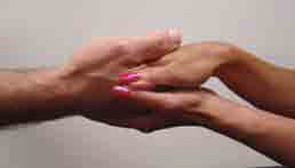My husband teaches sales classes at Michigan State University in East Lansing. During an etiquette dinner, students are encouraged to shake hands firmly to convey confidence and positive nonverbal cues to members that they call on in the industry. It was apparent to me that this common greeting must be challenged to prevent pain to a patient and the need to apologize for avoiding a handshake or a “polite” greeting.
A Case Study and a Lecture
The case of Robert illustrates the handshake dilemma. A businessman and a former college athlete, Robert is in great physical condition. At 45 years old, Robert stands 6’3” and weighs 250 pounds. Robert lives with rheumatoid arthritis (RA), and he knows all too well how painful a handshake can be. His arthritis has been controlled for two years on biologic and disease-modifying therapy. He continues to play pick-up hockey.
As I explained the topic to Robert, he agreed that it would help many people. He also offered his solution: “I just offer my left hand.” Confused, I asked what he meant. “I just offer my left hand, and that way people don’t squeeze it as hard,” he explained. Even Robert, a physically imposing person and athlete, was making adjustments to his greeting.
It was then that I realized that this problem didn’t limit itself to those with physical deformities to their hands, but to all who have chronic pain which affects their hands. Patients with scleroderma, fibromyalgia, RA, osteoarthritis, erosive osteoarthritis, gout, psoriatic arthritis, dermatomyositis, systemic lupus, reflex sympathetic dystrophy, Raynaud’s phenomenon, and polymyositis are just some of the patients affected with hand pain. My passion for this subject turned into a lecture for the Michigan’s Focus on Pain Conference in 2008, and the reception confirmed the widespread nature of this problem.



Solutions
Physical touch conveys empathy, shows connection, and raises the self-esteem of those who are touched. Based on experience, research, and patients, there are several ways to shake hands (see Table 1, below left).
Over the years, I found two solutions that work well for my patients and me. Most patients get a hug upon entering the room and before they leave the office. For patients with whom I am less familiar, or who are less receptive to physical touch, an open palm gentle touch to the forearm, shoulder, or knee and crouching to the patient’s eye level conveys that I care and plan to give them compassionate care without shaking their hand. In addition to touch, I always take the time to talk to our patients for at least two minutes before turning to the computer to review the electronic medical records.

